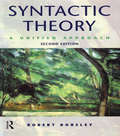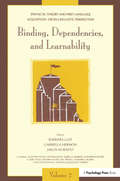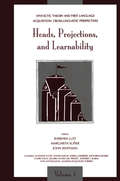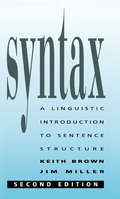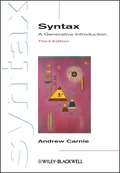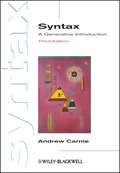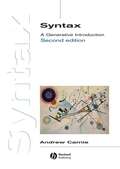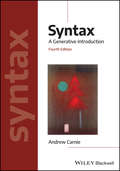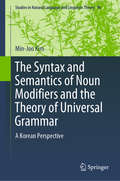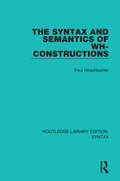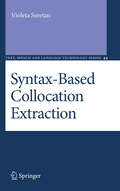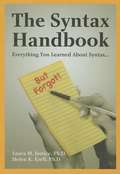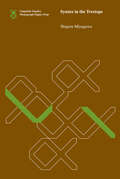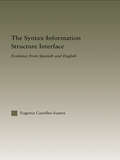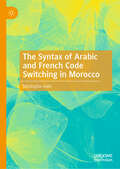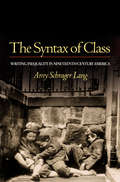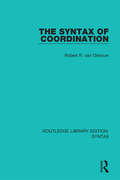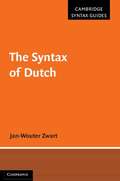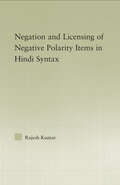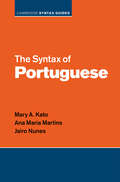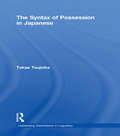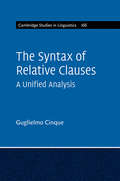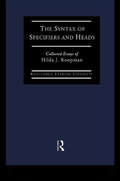- Table View
- List View
Syntactic Theory: A Unified Approach
by Robert BorsleySyntactic theory is central to the study of language. This innovative book introduces the ideas which underlie most approaches to syntax and shows how they have been developed within two broad frameworks: principles and parameters theory and phrase structure grammar. While other texts either concentrate on one theory or treat them as totally separate, here both approaches are introduced together, highlighting the similarities as well as the differences.Thoroughly updated in the light of major recent developments, this second edition includes expanded explanations of the main characteristics of the two theories, summaries of the main features, exercises reinforcing key points and suggestions for further investigation.
Syntactic Theory and First Language Acquisition: Cross-linguistic Perspectives -- Volume 1: Heads, Projections, and Learnability -- Volume 2: Binding, Dependencies, and Learnability
by Barbara Lust Gabriella Hermon Jaklin Kornfilt Suzanne Flynn Shyam Kapur Isabella Barbier Katharina Boser Claire Foley Zelmira Nuñez del Prado Edward J. Rubin Lynn Santelmann Jacqueline ToribioUniversal Grammar (UG) is a theory of both the fundamental principles for all possible languages and the language faculty in the "initial state" of the human organism. These two volumes approach the study of UG by joint, tightly linked studies of both linguistic theory and human competence for language acquisition. In particular, the volumes collect comparable studies across a number of different languages, carefully analyzed by a wide range of international scholars. The issues surrounding cross-linguistic variation in "Heads, Projections, and Learnability" (Volume 1) and in "Binding, Dependencies, and Learnability" (Volume 2) are arguably the most fundamental in UG. How can principles of grammar be learned by general learning theory? What is biologically programmed in the human species in order to guarantee their learnability? What is the true linguistic representation for these areas of language knowledge? What universals exist across languages? The two volumes summarize the most critical current proposals in each area, and offer both theoretical and empirical evidence bearing on them. Research on first language acquisition and formal learnability theory is placed at the center of debates relative to linguistic theory in each area. The convergence of research across several different disciplines -- linguistics, developmental psychology, and computer science -- represented in these volumes provides a paradigm example of cognitive science.
Syntactic Theory and First Language Acquisition: Cross-linguistic Perspectives -- Volume 1: Heads, Projections, and Learnability -- Volume 2: Binding, Dependencies, and Learnability
by Barbara Lust Margarita Suñer John Whitman Suzanne Flynn Shyam Kapur Isabella Barbier Katharina Boser Claire Foley Zelmira Nuñez del Prado Edward J. Rubin Lynn Santelmann Almeida Jacqueline ToribioUniversal Grammar (UG) is a theory of both the fundamental principles for all possible languages and the language faculty in the "initial state" of the human organism. These two volumes approach the study of UG by joint, tightly linked studies of both linguistic theory and human competence for language acquisition. In particular, the volumes collect comparable studies across a number of different languages, carefully analyzed by a wide range of international scholars. The issues surrounding cross-linguistic variation in "Heads, Projections, and Learnability" (Volume 1) and in "Binding, Dependencies, and Learnability" (Volume 2) are arguably the most fundamental in UG. How can principles of grammar be learned by general learning theory? What is biologically programmed in the human species in order to guarantee their learnability? What is the true linguistic representation for these areas of language knowledge? What universals exist across languages? The two volumes summarize the most critical current proposals in each area, and offer both theoretical and empirical evidence bearing on them. Research on first language acquisition and formal learnability theory is placed at the center of debates relative to linguistic theory in each area. The convergence of research across several different disciplines -- linguistics, developmental psychology, and computer science -- represented in these volumes provides a paradigm example of cognitive science.
Syntax: A Linguistic Introduction to Sentence Structure
by Keith Brown Jim MillerThe second edition of this invaluable introductory text takes account of developments in syntactic studies. Dealing with the whole range of syntax, this book explains, in a lucid and approachable way, why linguists have adopted certain solutions to problems and not others. This book introduces the basic concepts used in the description of syntax, independently of any single model of grammar. Profusely illustrated with diagrams, there are sets of exercises for every chapter which can be used in class or by students working independently.
Syntax: A Generative Introduction
by Andrew CarnieAndrew Carnie's bestselling textbook on syntax has guided thousands of students through the discipline of theoretical syntax; retaining its popularity due to its combination of straightforward language, comprehensive coverage, and numerous exercises.
Syntax: A Generative Introduction (Introducing Linguistics #18)
by Andrew CarnieAndrew Carnie’s bestselling textbook on syntax has guided thousands of students through the discipline of theoretical syntax; retaining its popularity due to its combination of straightforward language, comprehensive coverage, and numerous exercises. In this third edition, topics have been updated, new exercises added, and the online resources have been expanded. Supported by expanded online student and instructor resources, including extra chapters on HPSG, LFG and time-saving materials for lecturers, including problem sets, PowerPoint slides, and an instructors’ manual Features new chapters on ellipsis, auxiliaries, and non-configurational languages Covers topics including phrase structure, the lexicon, Case theory, movement, covert movement, locality conditions, VP shells, and control Accompanied by a new optional workbook, available separately, of sample problem sets which are designed to give students greater experience of analyzing syntactic structure
Syntax: A Generative Introduction
by Andrew CarnieBuilding on the success of the bestselling first edition, the second edition of this textbook provides a comprehensive and accessible introduction to the major issues in Principles and Parameters syntactic theory, including phrase structure, the lexicon, case theory, movement, and locality conditions.
Syntax: A Generative Introduction (Introducing Linguistics #30)
by Andrew CarnieThe extensively updated fourth edition of the leading introductory textbook on theoretical syntax, including an all-new chapter and additional problem sets Now in its fourth edition, Andrew Carnie's Syntax: A Generative Introduction remains the leading introduction to the rules, principles, and processes that determine the structure of sentences in language. Comprehensive yet accessible, the text provides a well-balanced, student-friendly introduction to syntactic theory. Topics include phrase structure, the lexicon, binding theory, case theory, movement, covert movement, locality conditions, ditransitives, verbal inflection and auxiliaries, ellipsis, control theory, non-configurational languages, and more. Students are provided with numerous exercises and pedagogical features designed to strengthen comprehension, review learning objectives, test knowledge, and highlight major issues in the field. The fourth edition features revised material throughout, including a new section on Chomsky's Merge and additional problem sets in every chapter, while new examples throughout the text broaden the appeal and relatability of the text to a more diverse set of students. The optional The Syntax Workbook: A Companion to Carnie's Syntax has also been thoroughly revised and expanded to offer students the opportunity to practice the skills and concepts introduced in the primary text. This classic textbook: Presents authoritative and comprehensive coverage of basic, intermediate, and advanced topics Includes ample exercises and clear explanations using straightforward language Offers extensive online student and instructor resources, including problem sets, PowerPoint slides, an updated instructor's manual, author-created videos, online-only chapters, and other supplementary material Features a wealth of learning tools, including learning objectives, discussion questions, and problems of varying levels of difficulty In the new fourth edition, Syntax: A Generative Introduction remains an essential textbook for beginning syntacticians, perfect for undergraduate and graduate course in linguistics, grammar, language, and second language teaching. Available as a set with The Syntax Workbook: A Companion to Carnie's Syntax, 2nd Edition
Syntax
by Robert FreidinSyntax: Basic Concepts and Applications provides a systematic introduction to core topics in syntax, focusing on how the basic concepts apply in the analysis of sentences. Assuming no background in linguistic analysis, the book gives students a working knowledge of syntactic analysis from a minimalist perspective. Step by step it explains the fundamentals of phrase structure, movement and deletion. Well-placed exercises throughout reinforce and extend the concepts and analyses presented in the text, allowing readers to gain understanding of progressively complex issues at a comfortable pace. Much of the data comes from English, but crucial examples are also drawn from a range of other languages, including Russian, Chinese, Japanese, French, Italian, Spanish, Irish, Welsh and Greek.
The Syntax and Semantics of Noun Modifiers and the Theory of Universal Grammar: A Korean Perspective (Studies in Natural Language and Linguistic Theory #96)
by Min-Joo KimThis book takes Korean as a basis to provide a detailed universal Determiner Phrase (DP) structure. Adnominal adjectival expressions are apparently optional noun dependents but their syntax and semantics have been shown to provide an important window on the internal structure of DP. By carefully examining data from Korean, an understudied language, as well as from other unrelated languages, the book provides a broad perspective on the phenomenon of noun modification and its cross-linguistic variations. Furthermore, it offers not only a thorough syntactic analysis but also a formal semantic analysis of noun modifiers that extends beyond a single language. This book will be of great interest to researchers interested in theoretical syntax, its interfaces with semantics, pragmatics, linguistic typology, and language variation.
The Syntax and Semantics of Wh-Constructions (Routledge Library Editions: Syntax #10)
by Paul HirschbuhlerThis title, first published in 1985, provides a detailed analysis of aspects of the semantics and the syntax of some wh-constructions. The first part of the book deals with the semantics of questions, whilst the other part discusses the syntax of que and quoi (what) in questions in French and the syntax of free relatives in French and other languages. This title will be of interest to students of language and linguistics.
Syntax-Based Collocation Extraction
by Violeta SeretanSyntax-Based Collocation Extraction is the first book to offer a comprehensive, up-to-date review of the theoretical and applied work on word collocations. Backed by solid theoretical results, the computational experiments described based on data in four languages provide support for the book's basic argument for using syntax-driven extraction as an alternative to the current cooccurrence-based extraction techniques to efficiently extract collocational data. The work described in Syntax-Based Collocation Extraction focuses on using linguistic tools for corpus-based identification of collocations. It takes advantage of recent advances in parsing to propose a novel deep syntactic analytic collocation extraction that has applicability to a range of important core tasks in Computational Linguistics. The book is useful for anyone interested in computational analysis of texts, collocation phenomena, and multi-word expressions in general.
The Syntax Handbook: Everything You Learned about Syntax ...(But Forgot)
by Laura M. Justice Helen K. EzellThe Syntax Handbook: Everything You Learned about Syntax (But Forgot) provides you with a reader-friendly review of the syntactic terms most frequently encountered and used by language interventionists.
Syntax in the Treetops (Linguistic Inquiry Monographs)
by Shigeru MiyagawaA proposal that syntax extends to the domain of discourse in making core syntax link to the conversational context.In Syntax in the Treetops, Shigeru Miyagawa proposes that syntax extends into the domain of discourse by making linkages between core syntax and the conversational participants. Miyagawa draws on evidence for this extended syntactic structure from a wide variety of languages, including Basque, Japanese, Italian, Magahi, Newari, Romanian, and Spanish, as well as the language of children with autism. His proposal for what happens at the highest level of the tree structure used by linguists to represent the hierarchical relationships within sentences—&“in the treetops&”—offers a unique contribution to the new area of study sometimes known as &“syntacticization of discourse.&” Miyagawa&’s main point is that syntax provides the basic framework that makes possible the performance of a speech act and the conveyance of meaning; although the role that syntax plays for speech acts is modest, it is critical. He proposes that the speaker-addressee layer and the Commitment Phrase (the speaker&’s commitment to the addressee of the truthfulness of the proposition) occur together in the syntactic treetops. In each succeeding chapter, Miyagawa examines the working of each layer of the tree and how they interact.
The Syntax-Information Structure Interface: Evidence from Spanish and English (Outstanding Dissertations in Linguistics)
by Eugenia Casielles-SuárezIn the last decade, the notions of topic and focus have come to play an increasingly relevant role in theoretical linguistics. Although these notions are often taken for granted, they are still poorly understood. This study offers a detailed analysis of the precise definitions of these and related terms (theme, topic, background, given information, focus, contrast, etc.) as well as of their combination into information structures such as the topic-focus and background-focus articulations. It recommends pursuing a feature-based typology of topics and argues against a dual nature of focus (i.e. presentational vs. contrastive). Central questions addressed are the analysis of subjects in Spanish and English (DP vs NP and null vs. preverbal vs. postverbal) and the nature of constructions such as topicalization, left-dislocation, and focus preposing. Further, it is proposed that in Spanish information structure can be read off the syntax: while an overt DP in the preverbal specifier subject position is interpreted as the topic in a topic-focus articulation, one or more left-or right-dislocated phrases are interpreted as part of the background in background-focus/focus-background structures.
The Syntax of Arabic and French Code Switching in Morocco
by Mustapha AabiThis book posits a universal syntactic constraint (FPC) for code switching, using as its basis a study of different types of code-switching between French, Moroccan Arabic and Standard Arabic in a language contact situation. After presenting the theoretical background and linguistic context under study, the author closely examines examples of syntactic constraints in the language of functional bilinguals switching between French and forms of Arabic, proposing that this hypothesis can also be applied in other comparable language contact and translanguaging contexts worldwide. This book will be of interest to students and scholars of French, Arabic, theoretical linguistics, syntax and bilingualism.
The Syntax of Class: Writing Inequality in Nineteenth-Century America
by Amy Schrager LangThe Syntax of Class explores the literary expression of the crisis of social classification that occupied U.S. public discourse in the wake of the European revolutions of 1848. Lacking a native language for expressing class differences, American writers struggled to find social taxonomies able to capture--and manage--increasingly apparent inequalities of wealth and power. As new social types emerged at midcentury and, with them, new narratives of success and failure, police and reformers alarmed the public with stories of the rise and proliferation of the "dangerous classes." At the same time, novelists as different as Maria Cummins, Nathaniel Hawthorne, Frank Webb, Elizabeth Stuart Phelps, and Horatio Alger Jr. focused their attention on dense engagements across the lines of class. Turning to the middle-class idea of "home" as a figure for social harmony and to the lexicons of race and gender in their effort to devise a syntax for the representation of class, these writers worked to solve the puzzle of inequity in their putatively classless nation. This study charts the kaleidoscopic substitution of terms through which they rendered class distinctions and follows these renderings as they circulated in and through a wider cultural discourse about the dangers of class conflict. This welcome book is a finely achieved study of the operation of class in nineteenth-century American fiction--and of its entanglements with the languages of race and gender.
The Syntax of Coordination (Routledge Library Editions: Syntax Ser.)
by Robert R. van OirsouwCoordination is a syntactic construction which occurs in most languages. In the past, it has been a fruitful area of research, but also a controversial one. Arguments from coordination have been used in support of transformations, and against phrase-structure rules, but also in support of phrase-structure rules and against transformations. This
The Syntax of Dutch
by Jan-Wouter ZwartDutch is a West-Germanic language closely related to English and German, but its special properties have long aroused interest and debate among students of syntax. This is an informative guide to the syntax of Dutch, offering an extensive survey of both the phenomena of Dutch syntax and their theoretical analyses over the years. In particular the book discusses those aspects of Dutch syntax that have played an important role in the development of syntactic theory in recent decades. Presupposing only a basic knowledge of syntax and complete with an extensive bibliography, this survey will be an important tool for students and linguists of all theoretical persuasions, and for anyone working in Germanic linguistics, linguistic typology and linguistic theory.
The Syntax of Imperatives
by Asier Alcázar Mario SaltarelliThe imperative clause is one of three major sentence types that have been found to be universal across the languages of the world. Compared to declaratives and interrogatives, the imperative type has received diverse analyses in the literature. This cutting-edge study puts forward a new linguistic theory of imperatives, arguing that categories of the speech act, specifically Speaker and Addressee, are conceptually necessary for an adequate syntactic account. The book offers compelling empirical and descriptive evidence by surveying new typological data in critical assessment of competing hypotheses towards an indexical syntax of human language. An engaging read for students and researchers interested in linguistics, philosophy and the syntax of language.
The Syntax of Negation and the Licensing of Negative Polarity Items in Hindi (Outstanding Dissertations in Linguistics)
by Rajesh KumarThis books studies syntax of NPIs and their interaction with sentential negatives in Hindi. It outlines the clause structure of Hindi and locates the syntactic position of sentential negatives as well as constituent negatives within the structure. It is argued that sentential negative in Hindi negation marker heads its own maximal projection, NegP, which is immediately dominated by TP. In addition to locating the position of negation markers in the clause structure, it outlines the distribution of negative polarity items (NPIs) in Hindi and the structural constraints on their licensing by sentential negative. The book argues that an NPI in Hindi is licensed overtly in the course of derivation by a c-commanding negative marker. The bulk of the evidence presented in this book argues against previous theoretical accounts that claim that NPI licensing involves covert syntactic operations such as LF movement or reconstruction. With respect to the classification of NPIs , this book also shows the existence of two different types of NPIs in Hindi; namely, strong NPIs and weak NPIs. Strong NPIs require a clause mate c-commanding negative licensor, whereas weak NPIs are quantifiers and are similar to free choice 'any' in English that are interpreted as NPIs in the presence of a c-commanding negative licensor.
The Syntax of Portuguese (Cambridge Syntax Guides)
by Mary A. Kato Ana Maria Martins Jairo NunesPortuguese is the second most spoken Romance language in the world, and due to recent interest in comparative syntax, the literature on its syntax has increased exponentially, resulting in exciting discoveries of a range of aspects that have hitherto been overlooked. This book provides a theoretically grounded overview of the major syntactic properties of Portuguese, focusing on the differences between European and Brazilian Portuguese. It shows from a theoretical point of view how different syntactic properties are interconnected by comparing and contrasting the variances between pronominal and agreement systems, null subjects, null complements, and word order. It also highlights how small differences in the specification of syntactic properties may yield quite different dialects. It introduces key theoretical points without technical jargon, making the content accessible to specialist and non-specialists alike. It is essential reading for both academic researchers and students of Portuguese language, comparative syntax, Romance linguistics, and theoretical syntax.
The Syntax of Possession in Japanese (Outstanding Dissertations in Linguistics)
by Takae TsujiokaFirst Published in 2002. Routledge is an imprint of Taylor & Francis, an informa company.
The Syntax of Relative Clauses: A Unified Analysis (Cambridge Studies in Linguistics)
by Guglielmo CinqueRelative clauses play a hugely important role in analysing the structure of sentences. This book provides the first evidence that a unified analysis of the different types of relative clauses is possible - a step forward in our understanding. Using careful analyses of a wide range of languages, Cinque argues that the relative clause types can all be derived from a single, double-headed, structure. He also presents evidence that restrictive, maximalizing, ('integrated') non-restrictive, kind-defining, infinitival and participial RCs merge at different heights of the nominal extended projection. This book provides an elegant generalization about the structure of all relatives. Theoretically profound and empirically rich, it promises to radically alter the way we think about this subject for years to come.
The Syntax of Specifiers and Heads: Collected Essays of Hilda J. Koopman (Routledge Leading Linguists)
by Hilda J KoopmanSpecifiers and Heads covers such topics as: * interpretation and distribution of pronouns * ECP effects * specifiers and phrase structure * the role and functioning of head movement * the architecture of grammar Each chapter draws syntactic arguments from phenomena in a broad range of languages and brings these to bear on the structure of syntactic theory and the understanding of crosslinguistic variation. Among the languages studied are the African languages, Welsh and Irish, Norwegian, French, English and Dutch.
